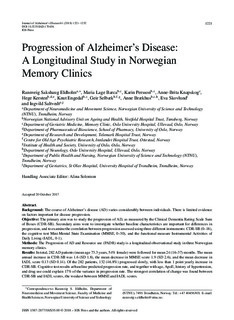Progression of Alzheimer's Disease: A Longitudinal Study in Norwegian Memory Clinics
Eldholm, Rannveig Sakshaug; Barca, Maria Lage; Persson, Karin; Knapskog, Anne-Brita; Kersten, Hege; Engedal, Knut; Selbæk, Geir; Brækhus, Anne; Skovlund, Eva; Saltvedt, Ingvild
Journal article, Peer reviewed
Published version
Permanent lenke
http://hdl.handle.net/11250/2497423Utgivelsesdato
2017Metadata
Vis full innførselSamlinger
Sammendrag
Background:
The course of Alzheimer’s disease (AD) varies considerably between individuals. There is limited evidence on factors important for disease progression.
Objective:
The primary aim was to study the progression of AD, as measured by the Clinical Dementia Rating Scale Sum of Boxes (CDR-SB). Secondary aims were to investigate whether baseline characteristics are important for differences in progression, and to examine the correlation between progression assessed using three different instruments: CDR-SB (0–18), the cognitive test Mini-Mental State Examination (MMSE, 0–30), and the functional measure Instrumental Activities of Daily Living (IADL, 0-1).
Methods:
The Progression of AD and Resource use (PADR) study is a longitudinal observational study in three Norwegian memory clinics.
Results:
In total, 282 AD patients (mean age 73.3 years, 54% female) were followed for mean 24 (16–37) months. The mean annual increase in CDR-SB was 1.6 (SD 1.8), the mean decrease in MMSE score 1.9 (SD 2.6), and the mean decrease in IADL score 0.13 (SD 0.14). Of the 282 patients, 132 (46.8%) progressed slowly, with less than 1 point yearly increase in CDR-SB. Cognitive test results at baseline predicted progression rate, and together with age, ApoE, history of hypertension, and drug use could explain 17% of the variance in progression rate. The strongest correlation of change was found between CDR-SB and IADL scores, the weakest between MMSE and IADL scores.
Conclusion:
Progression rate varied considerably among AD patients; about half of the patients progressed slowly. Cognitive test results at baseline were predictors of progression rate.
